Split to Mostar
The only ways to get from Split to Mostar is either by car or by bus. If wanting to do a day trip, then a car is the only practical method as the bus takes too long (5 hours). As we prefer and at least up to now use only public transportation in our travels, we went by bus. We highly recommend this option, but know that Mostar has two bus stations, East Mostar and West Mostar. Bus companies go to one or the other, but not both. The best way to research fare, times, etc. is here.
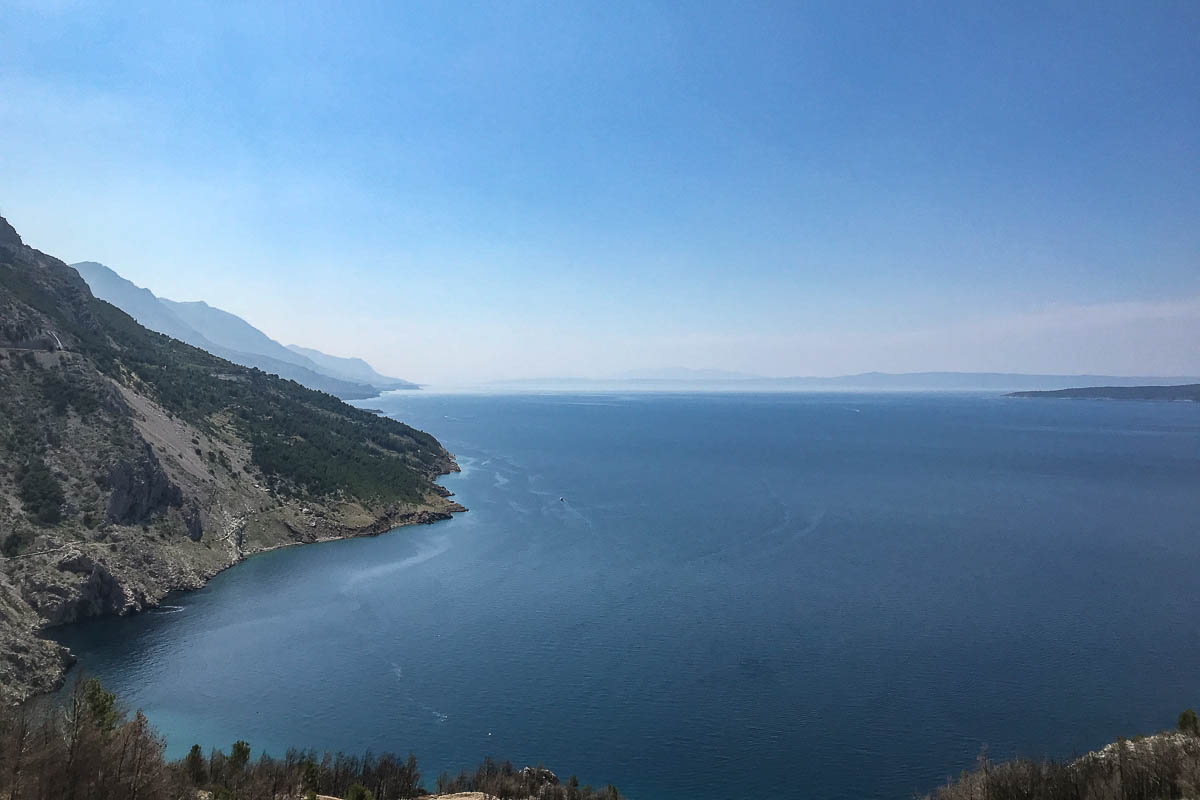
The route from Split to Mostar hugs the Dalmatian coastline. The twisty, two-lane road with spectacular scenery goes for quite a long time due to the Dinaric Alps that run very close to the Adriatic Sea. We passed one stunning beach after another, that is of course if you don’t mind pebbles, the norm of Dalmatian coast beaches.
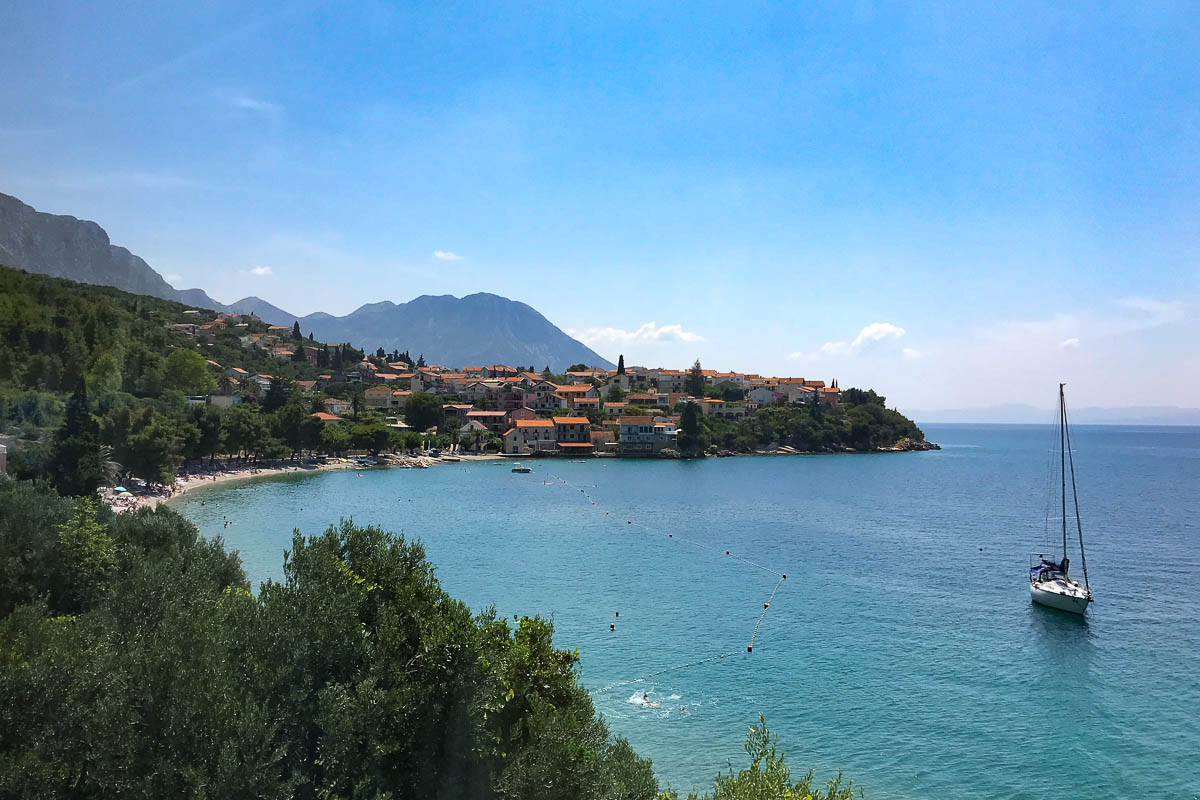
Border Crossing from Split to Mostar
The border crossing from Split to Mostar was a piece of cake, especially when compared to our crossing from Costa Rica to Panama last December. When we stopped on the Croatia side, we didn’t even get off the bus. The bus driver’s assistant collected all passports and took them into a nice-looking building. We were on our way in about 20 minutes. On the Bosnia and Herzegovina (BiH) side, we stopped at a hut and were back on the road in even less time. Our passports were returned, stamped out of Croatia, not stamped in to BiH.
Shortly after crossing into BiH, we stopped at a rest stop, which had squat toilets, reminiscent of China for Ann. We’re still wondering why the bus driver never informed the passengers (they usually do) that the break would be 20 minutes. We realized that the driver and his assistant got free lunch (and quite a spread it was!) for bringing passengers there. Had we known, we probably would have had lunch there too. Instead, we, along with several other passengers, stood outside the bus and waited.

Arrival in Mostar, a Divided City

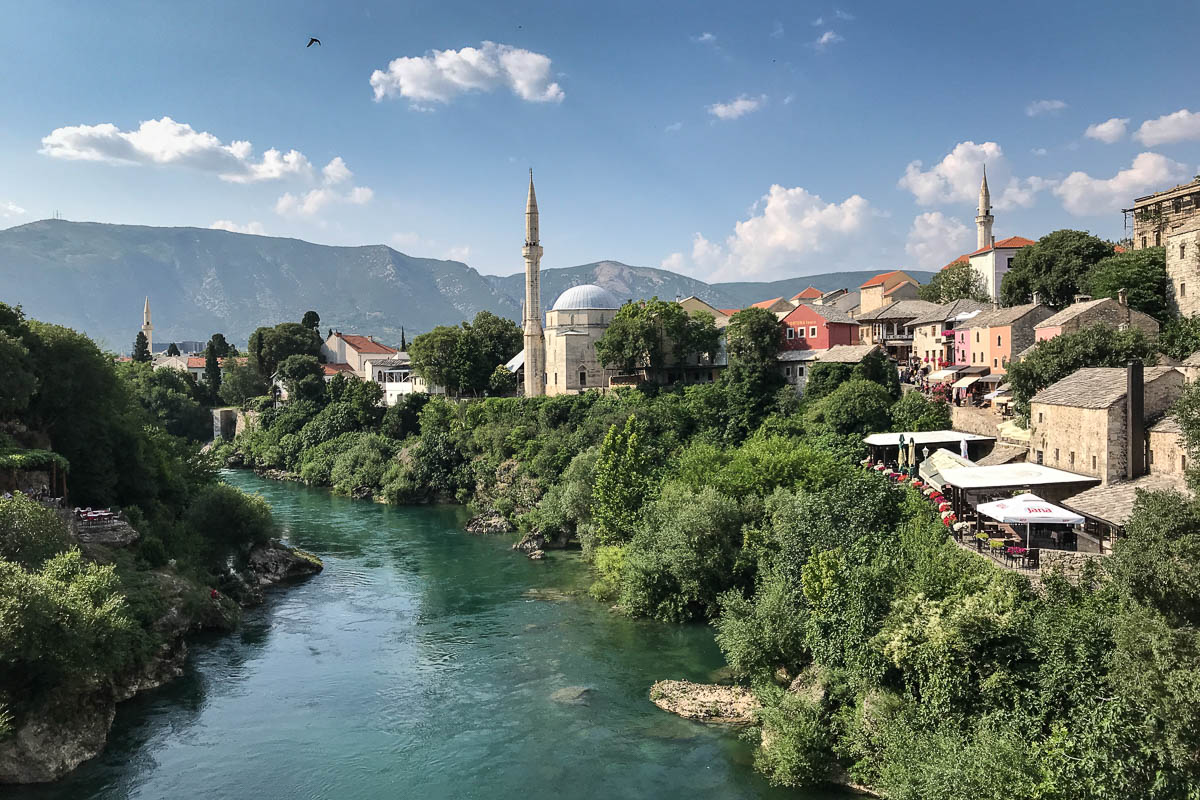
The divided city of Mostar is in a beautiful setting surrounded by green hills and mountains. In stark contrast are the many ugly Communist-era block buildings. Many of these buildings sport graffiti and even more have bullet holes, a visual reminder of the all too recent 1992-1995 Bosnian War. Our apartment was in one of these buildings, and the street was all torn up in the process of putting in a new sewer system. As an aside, a few days later, we recognized our street in photos from the war.
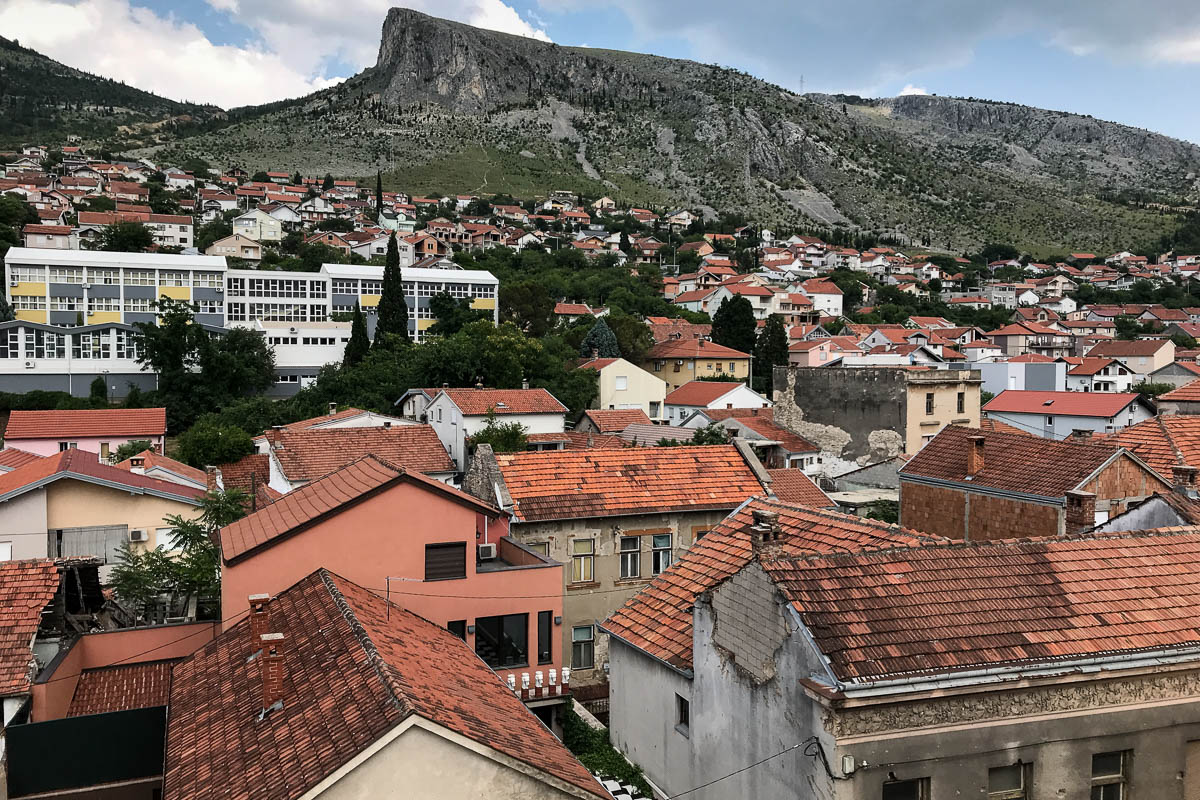
Why is Mostar a Divided City?
Prior to the war, under Tito, the different ethnic and religious groups lived in relative harmony. Once Tito died, conditions began to unravel with nationalism along religious lines, culminating in war. After the Army of the Republic of Bosnia and Herzegovina (ARBiH)and the Croatian Defence Council (HVO, Catholic) had successfully pushed back the Army of Republika Srpska (Bosnian Serbs, Orthodox) the HVO attempted to drive out the Muslim Bosniaks from western Herzegovina (including Mostar) so that they could join with Croatia .
Interestingly most of the people we talked to have a very favorable opinion of Tito. Unlike the picture we got in the west during the cold war.

The Dayton Accords signed on November 21, 1995 by the presidents of Bosnia, Croatia, and Serbia, ended the war. However, the agreement outlined only a general framework for peace in Bosnia and Herzegovina. The hope was that once the fighting stopped the groups could work together to form a single government. That never occurred and probably will not occur until the current generation who remembers the war is replaced by a younger generation.
The Famous Bridge in Mostar

The Neretva River runs north-south through Mostar and is crossed by many bridges. The most famous of these is Stari Most, literally “old bridge”, built in Ottoman times and destroyed during the war (since rebuilt). For the local people, the famous Stari Most is somewhat symbolic that Mostar is a divided city. Currently the east and west sides are mostly divided along religious lines. The west side is predominantly Croat (Catholic) and the east side predominantly Bosniak (Muslim).
Each side of the river have different schools, different local bus companies. Since the people of Mostar can’t agree on a city council, they can’t hold elections. Hence, the original mayor from post Dayton Accords is still the mayor. This lack of city government, and probably the scars of war, appear to have left an underlying guardedness between the Catholic Croats and Muslim Bosniaks.
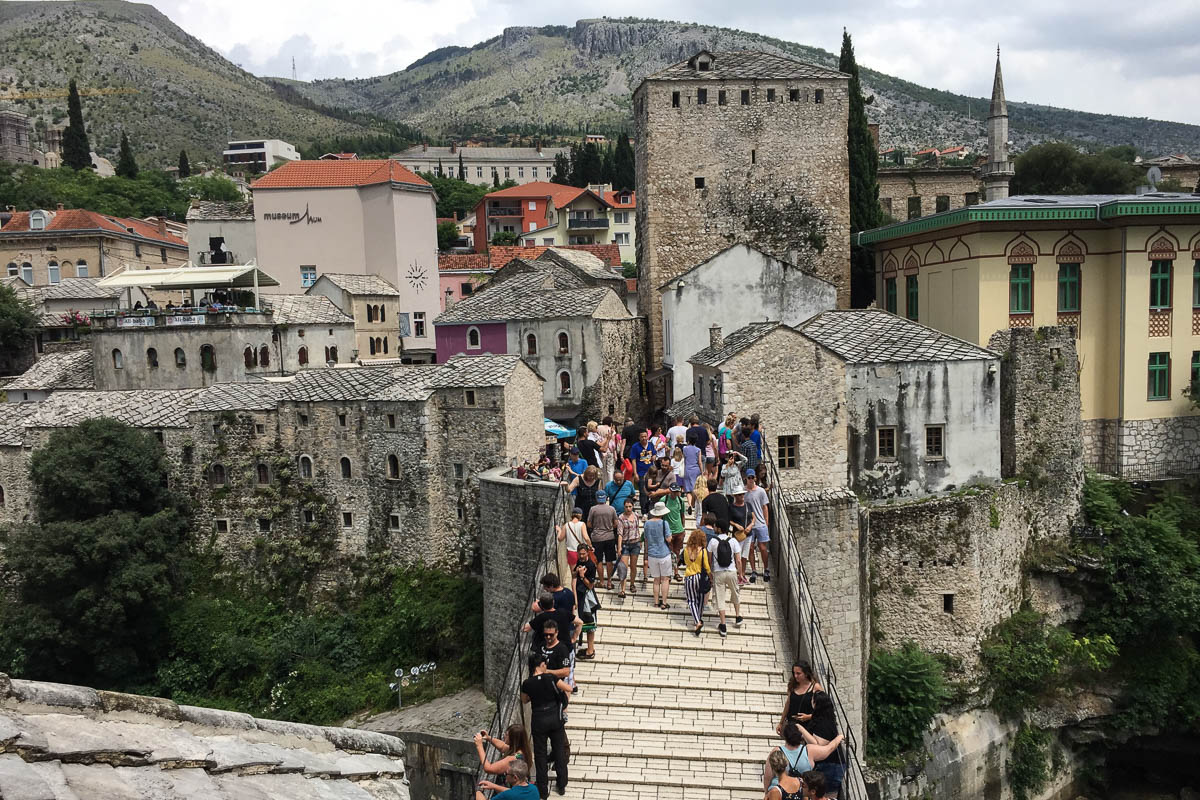
The Stari Most is what brings hoards of tourists to Mostar. In this case, the bridge is a good thing, as it puts much-needed tourist dollars into Mostar’s economy. Several men, both young and a bit older, appear to make their living by collecting money from tourists who want to see them jump off the bridge. The older men, buff in their Speedos, preen and collect the money. Then send a younger man dressed in board shorts and rash guard to jump into the cold river.
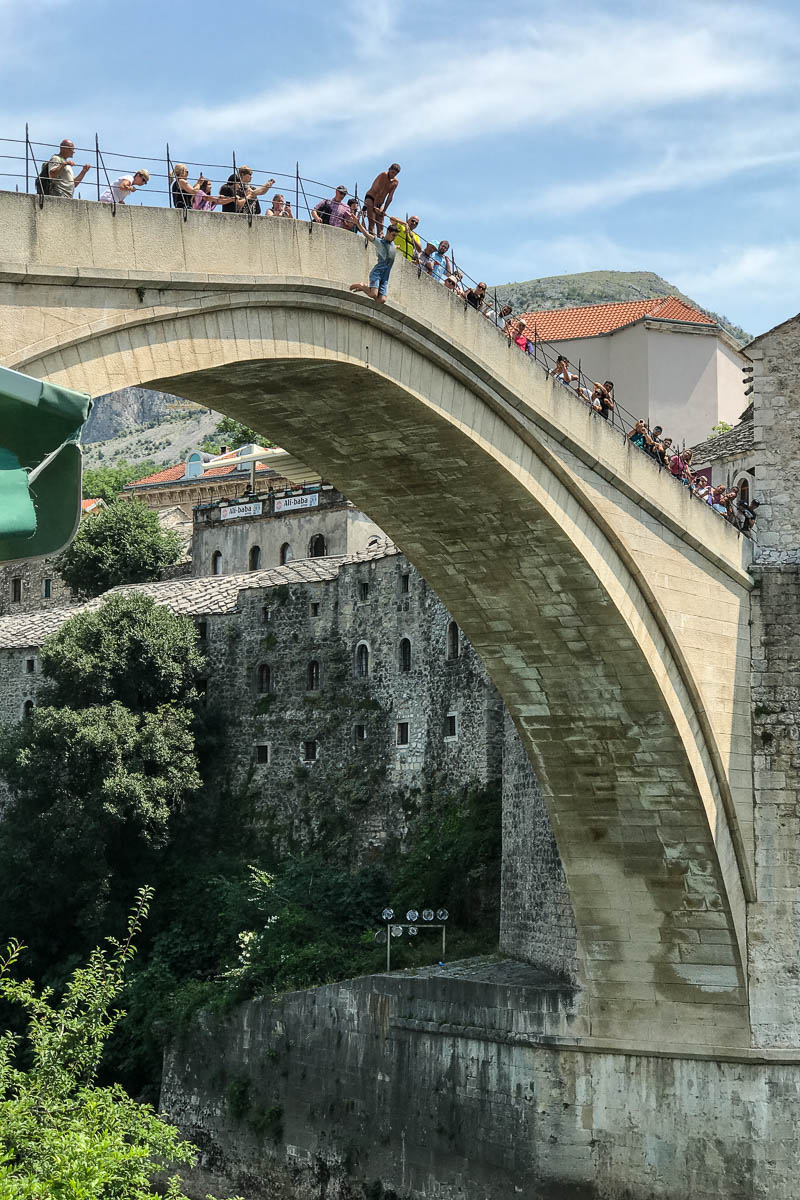

Mostar’s Old City
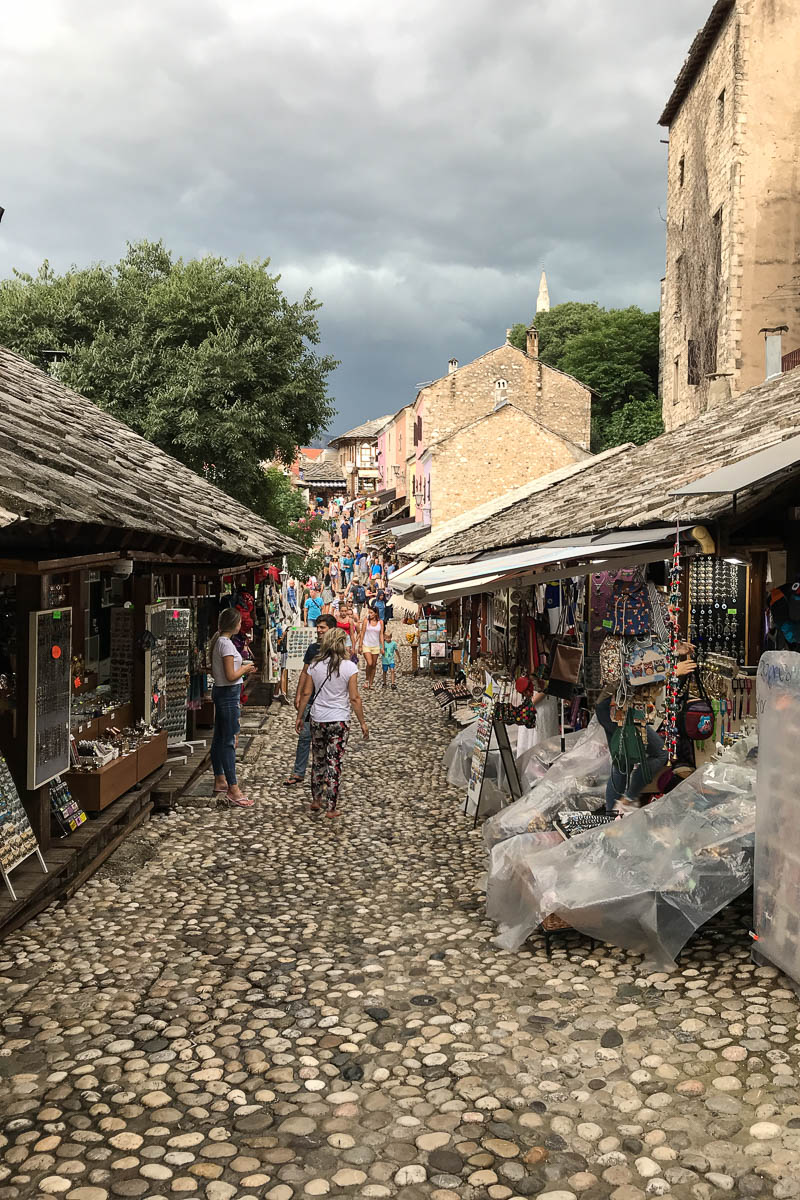
Many shops and restaurants fill Mostar’s Old City on both sides of the bridge. Despite the crowds, the area itself is quaint and picturesque, but beware the very slippery raised stone walkways. Especially on the bridge! The rebuilding of the bridge, from 2001-2004, used many of the stones from the original Ottoman construction. Ann usually held onto the rail while crossing the bridge. Plan B was to position your feet just so on the raised horizontal stones placed about every 12-14 inches.

Restaurants and Cafes
Restaurant and food prices in general are considerably less expensive in BiH than in Croatia. At the recommendation of our Airbnb host, we had a delicious lunch of traditional Bosnian food at Sadrvan .

We enjoyed some traditional Bosnian food: japrak (cabbage, minced meat, carrots, rice, parsley) and klepe, the filled pasta dish we had first tried at the Bosnian restaurant in Dubrovnik. Also as recommended, we enjoyed beer and Bosnian coffee at Karma Café while watching the bridge jumpers from below.
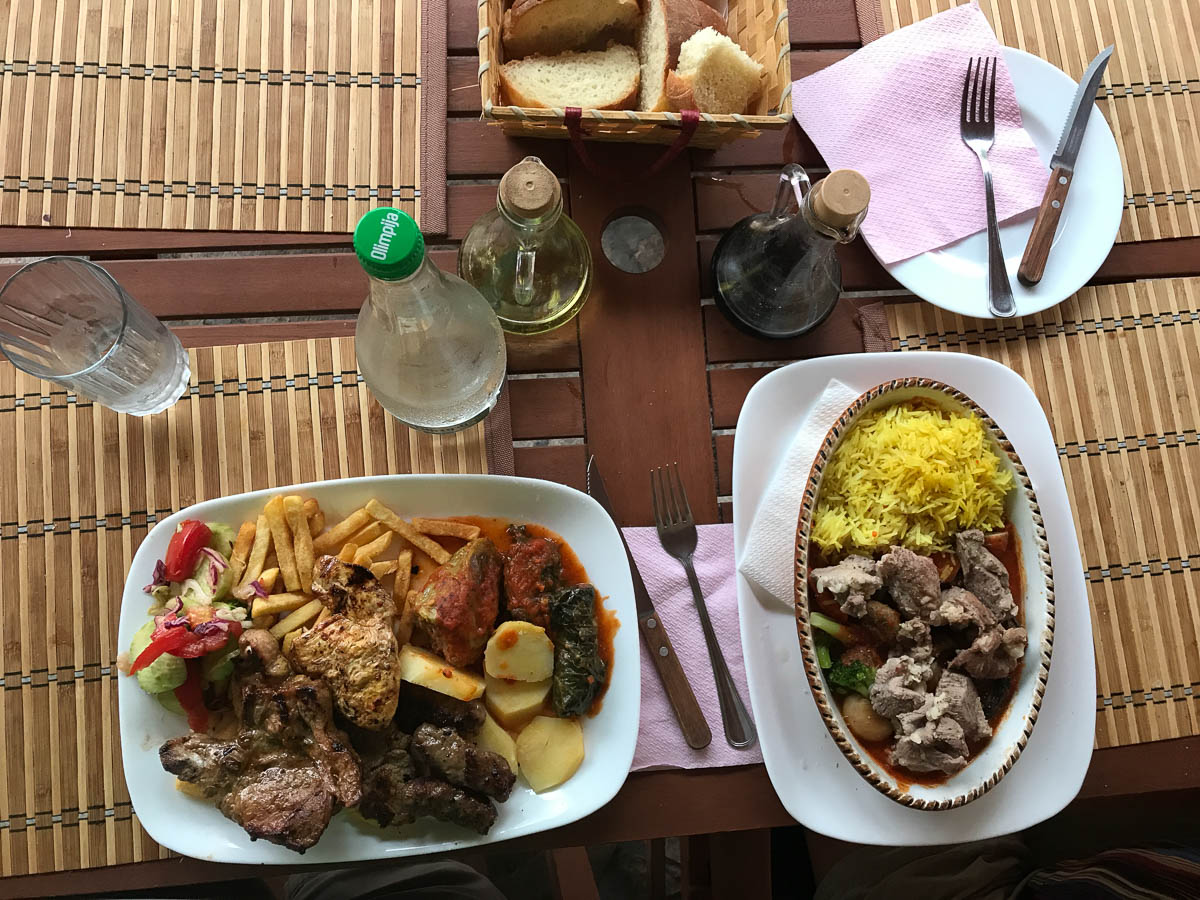
Bosnian Coffee
Bosnian coffee is served in a special, almost ceremonial way. The strong dark coffee is served in a džezva, a long-handled hand-engraved copper or tin coffee pot. The coffee is to be poured into a small handleless cup accompanied by sugar cubes. All this comes on a small engraved metal tray. You put your desired number of sugar cubes (Bosnians enjoy their coffee sweet) in the cup, then pour the coffee over. Alternatively, you can dip a cube in the coffee and suck on the cube.
Bosnian Hospitality
Our Airbnb apartment, as mentioned earlier, was in an ugly block building. The apartment was small but adequate, with some homey touches, but the balcony had a stunning view of the surrounding hillside. We stayed in Mostar three nights, before moving on to Sarajevo. Our host, Meliha, went out of her way to ensure we enjoyed our stay in Mostar and were introduced to other visitors.
Through Meliha’s employment, she was connected to a group of student interns from Dayton, Ohio in an exchange program with BiH. One evening, we were invited to Meliha’s home, in the next building from ours, to meet with this group of students and their chaperones. Arch Grieve, the founder/leader of the exchange program, is knowledgeable and passionate about BiH, and Mostar in particular. You can read about the program here .
The evening at Meliha’s home was spent sharing ideas and experiences along with Meliha’s yummy homemade baklava and Bosnian coffee. We were also served other traditional foods eaten in the evenings, such as dried meats, two types of cheeses, small marinated red peppers, along with some fresh bread baked by one of the students.
Museums in Mostar

Although Mostar has a variety of museums and other sights, we spent most of our time, as we are wont to do, just wandering the city. We walked from our apartment on the east side along the main pedestrian-only (not really, as is the case in other cities) street. Other times, we would wander the Old City, cross the Stari Most, or some other bridge, and explore the neighborhoods on the west side. However, we did visit one museum and a photo exhibition.
Museum of Crimes Against Humanity and Genocide 1992-1995
The Museum of Crimes Against Humanity and Genocide 1992-1995 opened in Sarajevo in July of 2016. Some time later a museum of the same name opened in Mostar. Admission is 10 BAM (Bosnian Convertible Mark), about $6. Although the museums are not identical, their purpose is. Both aim to explicitly report the horrors of the genocide that took place during the war. Exhibits include photos, letters, diaries, and personal items of victims and survivors, presented in a sobering way. The museum in Mostar included a video of the siege of Sarajevo and how people lived, or died, through it. The experience for us was heartbreakingly sad, but a reality that must be told. We learned in school about the genocide during WWII which took many more lives, but we kept reminding each other that the Bosnian War and the genocide in East Bosnia, including the massacre in Srebrenica (which was under UN protection), and occurred during our lifetime….
War Photo Exhibition
We also climbed the western tower of Stari Most to visit the War Photo Exhibition, admission 6 BAM ($3.60). The outstanding reporting of Wade Goddard , a young photo journalist from New Zealand, helped fill in the war history gaps for us. It was here that we saw a photo of our apartment building and street, one of the few places in the city where people could get water during the war. It was here also, through this exhibition, all in black and white, that we learned that there were actually two wars. The first stage of the Bosnian war was the Christian Orthodox Serbs against Croats and Bosniaks fighting together on the same side. The second stage was between the Catholic Croats and the Muslim Bosniaks. All in the name of ethnic and religious cleansing….

Mostar Wrap-Up
Many people visit Mostar as a day trip from Dubrovnik. Mostar has several excellent museums and scenic hikes in, near, and a short distance from the city. We highly recommend spending at least one overnight when visiting Mostar. We were there in June, and it was just too hot for us to consider it a possible expat destination. Oh, and by the way, if you’re planning on walking over to the train station to purchase tickets to travel to your next destination, don’t make the mistake we did. The ticket window is closed from 12:00-14:00 for lunch.
Next Up: Sarajevo
Ian & Ann

4 Comments
Would like to hear how you prepared for such a long trip.
Hi Marge,
Are you asking about how we prepare to leave or how we decide where we are going next?
Ian & Ann
You take absolutely stunning photographs!
Also think you were able to gain an understanding of the war better than I ever was. In 1993, at a conference in Bratislava, I met a woman from Sarajevo – Suzanna. She was extremely scared of what was happening in the country. She also thought Tito had done a competent job and the people were able to live comfortably under him. Now, her son was about to be constricted into the army and be required to kill and would probably be killed or wounded. Her daughter would be constricted into nursing and caring for the wounded. They had lost their small pleasure boat and a small country cabin – taken over by the government. I’ve so often wondered what happened to her and her family. We went on a Eastern European Cruise several years ago. They did an excellent job of showing and explaining the war. However, it still is difficult to understand, probably because of so many facets.
Hi Karen,
Yes, we agree that understanding this war is not an easy task, even today. We continued to learn more each day we spent in Mostar and Sarajevo (next post out soon). You mentioned that you met a woman from Sarajevo while the war was going on, and her fears and the experiences of her family unfortunately were common. It is our impression that people who lived through the war had/have memories and impressions that changed during the war and continue to change today. Often, their experiences, memories, and attitudes are a reflection of their ages.
Ian & Ann